Thinking about getting a personal loan but worried about the interest rates? The world of borrowing can seem overwhelming. But knowing what affects personal loan rates is key to making a smart choice. Your credit score and the lender you pick play big roles in the rate you get. The average rate is 12.42%, but it can change a lot based on your financial situation.
Key Takeaways
- The average personal loan interest rate is currently 12.42%, but can range from as low as 10.73% for excellent credit to over 30% for poor credit.
- Your credit score is the primary factor that determines the interest rate you’re offered on a personal loan.
- Factors like income, debt-to-income ratio, loan term, and loan amount can also affect your personal loan interest rate.
- Comparing rates from multiple lenders, including online lenders, banks, and credit unions, is essential to finding the most competitive rate for your situation.
- Personal loan rates are closely tied to economic conditions and can be influenced by factors like inflation and Federal Reserve policies.
Average Personal Loan Interest Rates by Credit Score
Your credit score greatly affects personal loan interest rates. Those with excellent credit, meaning a score of 720 or higher, get rates from 10.73% to 12.50%. This is because they are seen as less risky to lend to.
People with good credit, scores between 690 and 719, can expect rates from 13.50% to 15.50%. These rates are still good but higher than those for excellent credit scores.
Excellent Credit and Interest Rates
Borrowers with scores from 720 to 850 get the lowest average personal loan interest rates. This is because they have shown they can manage their finances well.
Good Credit and Interest Rates
Those with scores between 690 and 719 can still get competitive average personal loan interest rates. These rates are a bit higher than for excellent credit but still attractive to lenders.
“Excellent credit scores are a strong indicator of financial responsibility, which lenders reward with the best personal loan interest rates.”
What is The Interest Rate on a Personal Loan?
The interest rate on a personal loan is very important. It’s a percentage of the loan amount and affects the total cost. The rate depends on your credit score, the loan’s length, and the lender’s costs.
Unsecured personal loans usually have higher rates than secured ones. This is because secured loans are seen as safer for lenders, as they can claim collateral if you default.
Understanding Personal Loan Interest Rates
The latest Federal Reserve data shows the average 24-month personal loan rate is 8.73%, down from 10.32% in 2018. But, loans with excellent credit can have APRs under 4%, showing very low rates are possible.
For loans for debt consolidation, credit card refinancing, or other needs, rates range from 7.8% to 35.99%. Loan amounts are $1,000 to $50,000, and repayment periods are 36 to 60 months. You need a FICO or Vantage score of at least 300 for these loans.
Loans for big expenses or emergencies have rates from 18.00% to 35.99%. Loan amounts are $1,500 to $20,000, and repayment periods are 24 to 60 months.
Factors Affecting Personal Loan Interest Rates
Several things can change the interest rate on a personal loan. Your credit score, income, and job history are key. Higher credit scores mean lower rates, as you’re seen as less risky. A steady income and job history also help get better rates.
| Credit Score | Average APR |
|---|---|
| Excellent (720-850) | 11.30% |
| Good (690-719) | 15.60% |
| Fair (630-689) | 22.30% |
| Bad (300-629) | 25.20% |
Knowing what affects personal loan interest rates helps you make better choices. This way, you can get more favorable terms when applying for a loan.
Factors Affecting Personal Loan Interest Rates
Your credit score is key when it comes to personal loan interest rates. Those with excellent credit scores (720-850) get the lowest rates. On the other hand, those with poor credit (below 629) might see rates up to 32%. Lenders look at your credit score to figure out the risk of lending to you.
Your income and job history also matter a lot. A higher income and stable job can lead to lower rates. This is because lenders see these borrowers as less risky. But, those with a lower income or unstable job might get higher interest rates.
Credit Score’s Impact
- Excellent credit (720-850): Lowest rates
- Good credit (670-719): Moderate rates
- Fair credit (580-669): Higher rates
- Poor credit (below 579): Highest rates, up to 32%
Income and Employment
- Higher income: Qualify for lower rates
- Stable employment: Viewed as less risky by lenders
- Lower income: Offered higher interest rates
- Unstable employment: May result in higher rates
“Your credit score is the single most important factor in determining your personal loan interest rate. Borrowers with excellent credit can often qualify for the best rates, while those with poor credit may face significantly higher costs.”
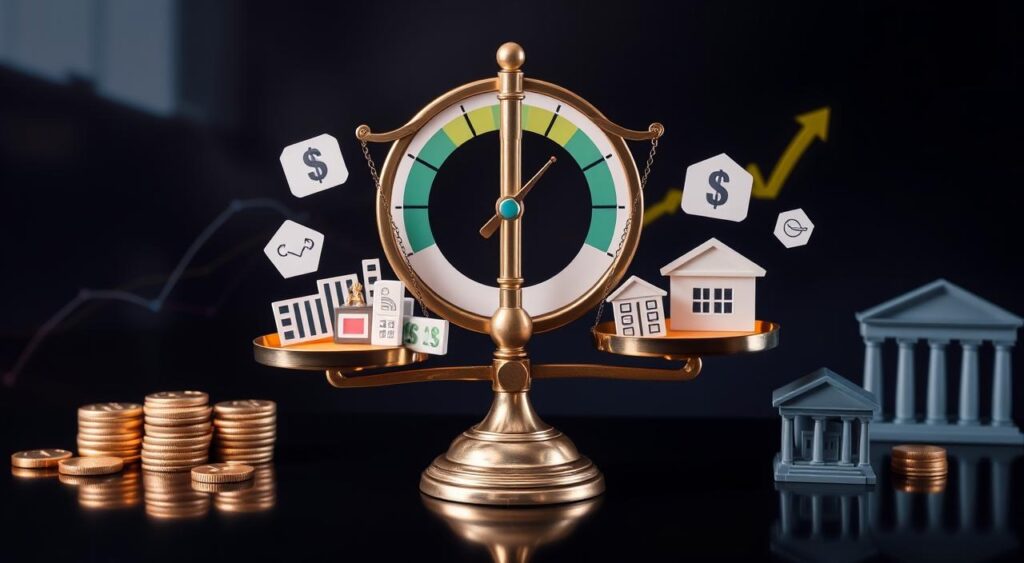
Unsecured vs. Secured Personal Loans
When looking at personal loans, you can pick between unsecured and secured loans. Knowing the differences helps you choose the right one for your money needs.
Unsecured loans don’t need collateral. They’re based on your credit and income. These loans have higher rates, from 6% to 36%. But, the best rates go to those with excellent credit.
Secured loans, however, use an asset like a car or home as collateral. They often have lower rates, about 20% less than unsecured loans.
Secured loans might have better rates, but you risk losing the asset if you can’t pay. Unsecured loans don’t have this risk. They’re better for those without valuable assets.
| Feature | Unsecured Personal Loans | Secured Personal Loans |
|---|---|---|
| Collateral | No collateral required | Backed by an asset (e.g., car, home) |
| Interest Rates | 6% to 36% | About 20% lower than unsecured loans |
| Borrowing Limits | Typically lower | Typically higher |
| Credit Requirements | Stricter | May be more flexible |
The choice between unsecured and secured loans depends on your financial situation and credit. Understanding both options helps you make a choice that fits your goals.
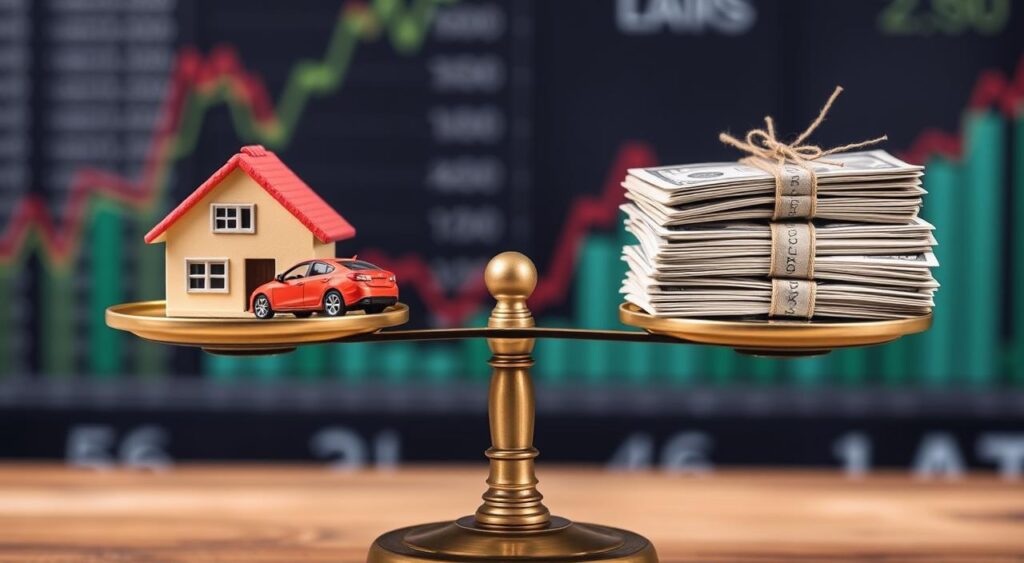
Average Rates from Online Lenders
Online lenders offer a variety of personal loan interest rates. The annual percentage rates (APRs) can range from 7.49% at LightStream to 35.99% at Avant, Best Egg, and Upstart.
Online Lender Rate Ranges
The rates online lenders give depend on who they think will borrow and the borrower’s credit score. Here’s a look at some popular online lenders’ rate ranges:
- Upstart offers loans from $1,000 to $50,000, with APRs from 7.80% to 35.99%.
- Discover Personal Loans has loans from $2,500 to $40,000, with APRs from 7.99% to 24.99%.
- SoFi Personal Loans range from $5,000 to $100,000, with APRs from 8.99% to 29.99%.
- Upgrade offers loans from $1,000 to $50,000, with APRs from 9.99% to 35.99%.
- Reach Financial Personal Loans offers amounts from $3,500 to $40,000, with APRs from 5.99% to 35.99%.
The rate you get will depend on your credit score, income, debts, loan term, and amount. It’s smart to shop around and compare rates from different online lenders. This way, you can find the best rate for your needs.
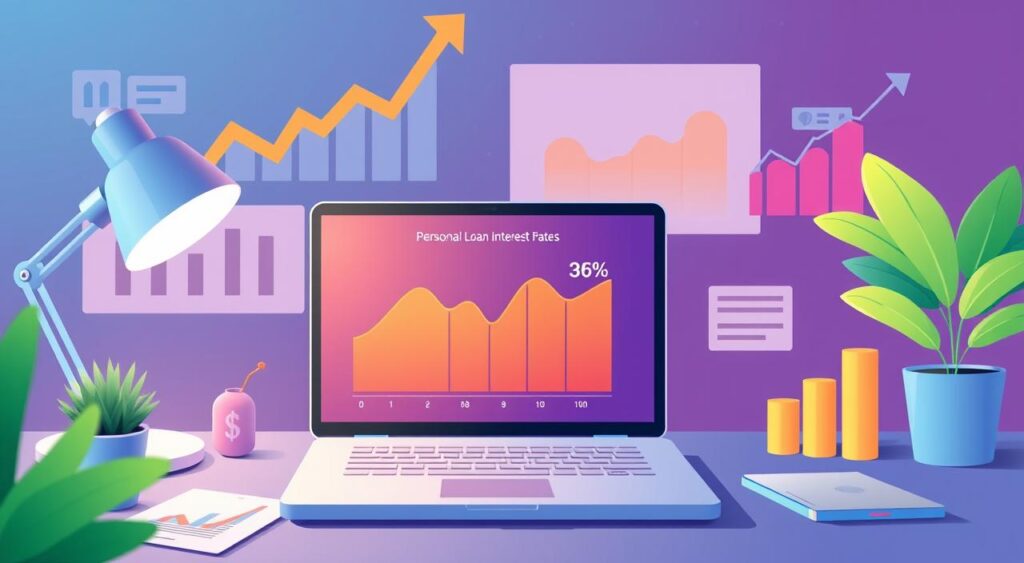
Average Rates from Banks
Bank personal loan interest rates can vary a lot. Bankrate says they usually range from 7.99% to 24.99%. The rate you get depends on your credit score, income, and how long you’ve been with the bank.
People with excellent credit scores (720 and up) might get rates from 7.99% to 15.36%. Those with good credit scores (670 and up) could see rates from 10.54% to 26.93%. If you have fair credit (580 to 669) or poor credit (below 580), rates can be higher, from 15.63% to 30.60%.
| Credit Score Range | Average Personal Loan APR |
|---|---|
| Excellent (781-850) | 6.39% |
| Prime (661-780) | 10.54% |
| Near Prime (601-660) | 15.63% |
| Subprime (500-600) | 17.27% |
| Deep Subprime (300-499) | 17.35% |
Banks look at your income, job, and how long you’ve been with them when setting rates. If you make more money, have a stable job, and have been with the bank for a while, you might get a better rate.
“The average personal loan interest rate is 25.92%, and the average loan term is 47.5 months with an average loan amount of $13,487.”
It’s smart to compare rates from different banks. This way, you can find the best bank personal loan interest rates and terms for your needs.
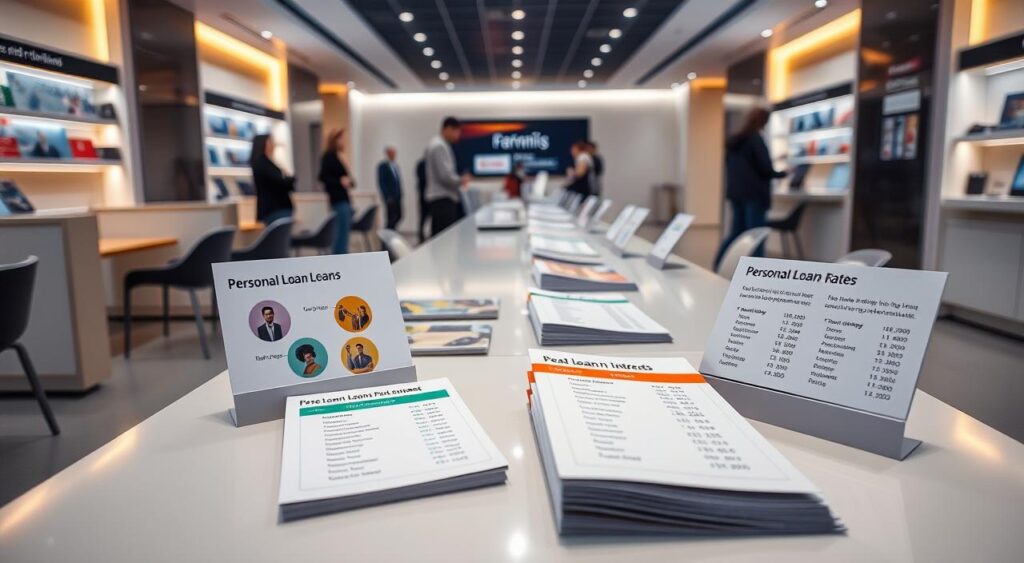
Average Rates from Credit Unions
Credit unions often have some of the best personal loan rates. Rates can go from 7.99% to 17.99% APR. This is usually lower than what banks or online lenders offer.
The rate you get from a credit union depends on your credit and how long you’ve been a member. They look at your credit score, income, and how much debt you have. If you have good credit and have been with the credit union for a while, you might get a better rate.
Credit Union Rate Ranges
Here are some examples of personal loan rates from top credit unions:
- Patelco Credit Union: 9.30% – 17.90% APR
- NASA Federal Credit Union: 9.84% – 18.00% APR
- PenFed Credit Union: 8.99% – 17.99% APR
- Blue Federal Credit Union: 10.99% – 17.99% APR
- First Tech Federal Credit Union: 8.14% – 18.00% APR
These credit unions offer loans from $300 to $100,000. You can pay them back in 6 months to 84 months. Each credit union has its own rules for who can join, so check with yours for details.
Overall, credit unions are a great choice for personal loans. They often have lower rates than banks or online lenders.
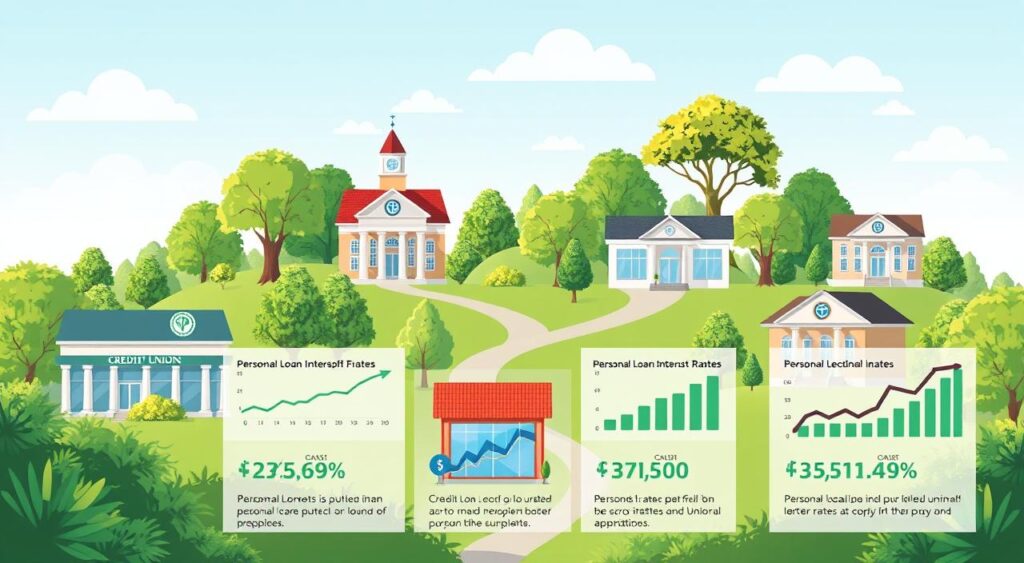
Personal Loan Rate Trends
Since March 2022, personal loan rates have gone up. The Federal Reserve has raised interest rates to fight inflation. The average rate for 3-year loans was 15.02% APR as of September 22, 2024. This is a slight drop from the week before but still higher than last year.
For 5-year loans, the average rate was 21.63% APR. This is a small decrease from the week before but still higher than last year’s rate. Experts think rates will keep going up because of the Federal Reserve’s actions.
Some predict rates might drop in 2024, but a weak economy could keep them high. This is especially true for those with lower credit scores. Lenders are making it harder to get loans as more people struggle to pay back debt.
| Loan Type | Current Rate | Previous Week | 1 Year Ago |
|---|---|---|---|
| 3-Year Personal Loan | 15.02% APR | 15.23% APR | 14.71% APR |
| 5-Year Personal Loan | 21.63% APR | 21.95% APR | 20.41% APR |
Those with great credit can still get good rates. But, those with lower credit scores will pay more. It’s smart to look around for the best deals on personal loans.
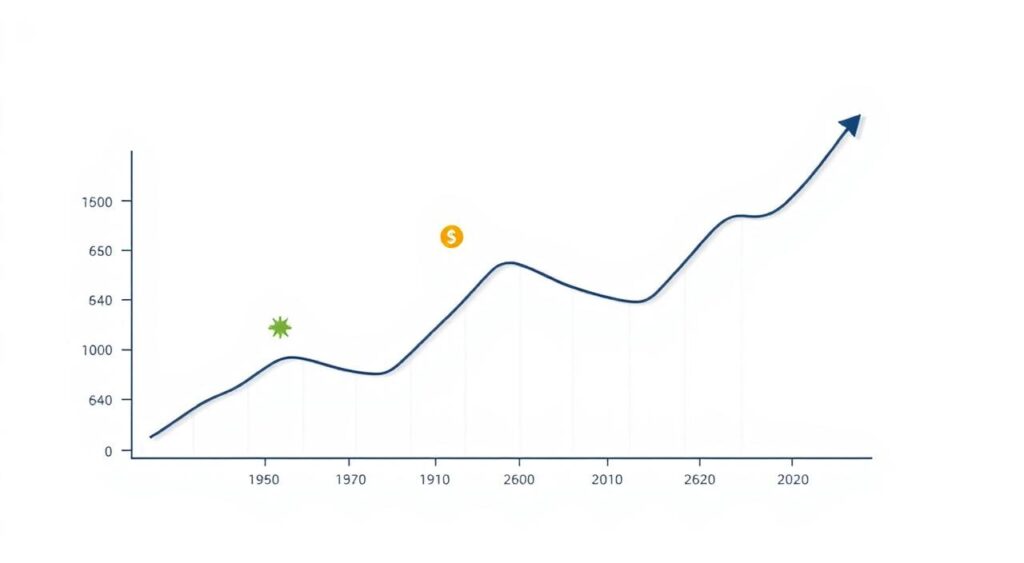
How the Fed Rate Impacts Personal Loan Rates
The Federal Reserve’s interest rate, known as the “Fed rate,” affects mortgage and auto loan rates a lot. But, its effect on personal loan rates is different. Personal loans aren’t directly linked to the Fed rate. Yet, the Fed’s policies can still influence personal loan prices over time.
When the Federal Reserve raises interest rates, the prime rate goes up too. This can make personal loan rates higher, especially for those with average or lower credit scores. On the other hand, when the Fed lowers rates, the prime rate drops. This might lead to lower personal loan rates.
It’s key to remember that personal loans are usually fixed-rate. So, current borrowers aren’t right away affected by Fed rate changes. But, new borrowers or those looking to refinance might see the effects of rate changes in the interest rates they’re offered.
| Timeline | Federal Funds Rate | Prime Rate | Average Personal Loan Rate |
|---|---|---|---|
| Beginning of 2022 | 0.5% | 3.5% | 10.28% |
| September 2022 | 3.25% | 6.75% | 11.76% |
| September 2024 | 4.75% – 5% | 8% | 12.42% |
Economists think that as the Federal Reserve cuts rates, personal loan rates might go down a bit. But, this change will likely be small for those with good credit. For those with average or lower credit, the Fed rate changes could have a bigger impact on their loan rates.
In short, the Fed rate doesn’t directly affect personal loan rates. But, it does so indirectly through changes in the prime rate and the economy. Borrowers can find better personal loans by improving their credit scores and considering co-borrowers, even when rates are high.
Personal Loan Rates vs Other Loan Types
Personal loans usually have higher interest rates than mortgages and auto loans. This is because personal loans are not secured by collateral. Lenders face more risk, leading to higher rates.
The Federal Reserve says the average APR for a two-year personal loan is 9.58%. Personal lines of credit have rates from 9.30% to 17.55%. Some, like First Republic, offer rates as low as 2.25%.
Credit card rates average 16.30%, but can hit 24%. For example, the Citi Double Cash Card has a 0% intro-APR for 18 months, then rates from 18.74% to 28.74%.
Personal loans might have origination and early pay-off fees. Personal lines of credit can have annual fees and late payment fees. Late fees can be about 7.5% of the amount due. Always talk to a financial advisor for a solid repayment plan.
Comparing Loan Types
| Loan Type | Average APR | Key Considerations |
|---|---|---|
| Personal Loan | 9.58% | Unsecured, may have origination and early pay-off fees |
| Personal Line of Credit | 9.30% – 17.55% | Variable rates, may have annual, late payment, and return payment fees |
| Credit Card | 16.30% – 24% | Variable rates, potential for high interest charges |
When looking at loans, think about the rates, fees, and terms. Getting advice from a financial expert can help you choose wisely.
Shopping Around for Best Rates
Looking for the best personal loan rates means you should compare offers from different lenders. Both online and traditional banks let you pre-qualify without hurting your credit score. This way, you can see various rates and terms without any risk.
Pre-qualifying for Rates
Getting pre-qualified for a personal loan is easy. Lenders just need some basic info like your credit score and income. They then give you an estimate of the interest rate and loan terms you might get. This helps you find the best deal before you apply.
By pre-qualifying with several lenders, you can make sure you’re getting a great loan deal. In the first quarter of 2023, the average personal loan was $7,100, according to TransUnion. PenFed Credit Union offers rates from 7.99% to 17.99%, showing that better credit scores get better rates.
| Lender | Interest Rate Range | Loan Amount | Repayment Term |
|---|---|---|---|
| Online Lender A | 6.99% – 24.99% | $1,000 – $50,000 | 1 – 7 years |
| Traditional Bank B | 8.99% – 19.99% | $5,000 – $100,000 | 2 – 10 years |
| Credit Union C | 7.99% – 17.99% | $2,500 – $35,000 | 1 – 5 years |
By comparing and pre-qualifying for personal loans, you can find the best rates and terms. This can save you a lot of money over time.
Conclusion
Personal loan interest rates are very important when you need money. Knowing what affects these rates, like your credit score and income, helps you make smart choices. It’s key to look at different lenders and compare their offers.
Shopping around and improving your credit score can help you get better rates. This way, you can find the loan that fits your budget and goals. This guide will help you understand the personal loan market better.
Remember, personal loan rates vary a lot. Your financial situation greatly influences the rates you can get. By exploring your options and improving your credit, you can get the best rates. This will make borrowing easier and more affordable for you.
FAQ
What is the average personal loan interest rate?
The average personal loan interest rate is 12.42%, according to Bankrate. Those with excellent credit can get rates under 11%. But, poor credit can lead to rates over 30%.
How do credit scores affect personal loan interest rates?
Your credit score greatly affects your loan interest rate. Excellent credit (720-850) means lower rates. Poor credit (below 629) can lead to rates up to 32%.
What other factors impact personal loan interest rates?
Besides credit score, income and job history matter too. A higher income and stable job can get you lower rates. Lenders see these as less risky.
What are the differences between unsecured and secured personal loans?
Unsecured loans have higher rates than secured ones. Secured loans are backed by collateral, making them less risky for lenders. This leads to lower rates for secured loans.
What are the average personal loan interest rates from different lenders?
Online lenders offer rates from 7.49% (with autopay) at LightStream to 35.99% at Avant, Best Egg, and Upstart. Banks offer rates from 7.99% to 24.99%. Credit unions have rates between 7.99% and 17.99%.
How have personal loan interest rates been trending?
Rates have been rising since March 2022, when the Federal Reserve started raising rates to fight inflation. Some predict rates will drop in 2024. But, a weak economy could keep rates high, especially for those with lower credit scores.
How does the Federal Reserve’s benchmark rate impact personal loan interest rates?
Personal loans aren’t directly tied to the Federal Reserve’s rate. While rate cuts and a strong economy might lower rates, small changes don’t have a big impact.
How can I find the best personal loan interest rate?
To find the best rate, shop around and compare offers. Many lenders let you pre-qualify without a hard credit check. This way, you can compare rates and terms without hurting your credit score.

